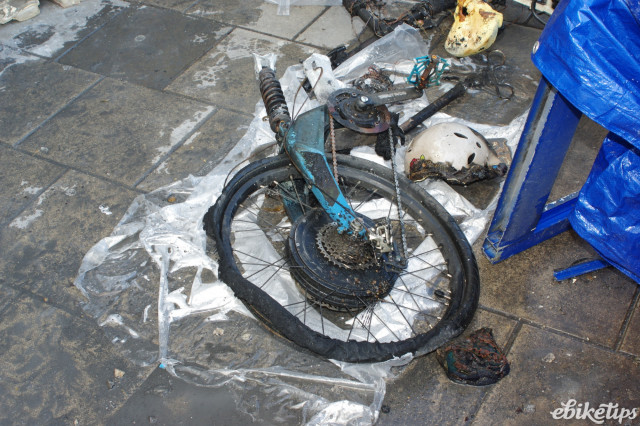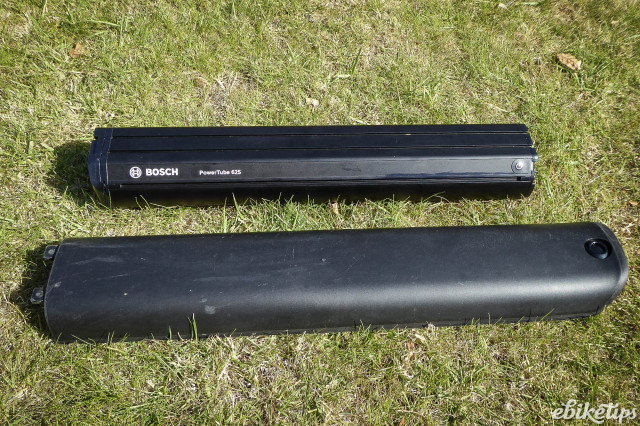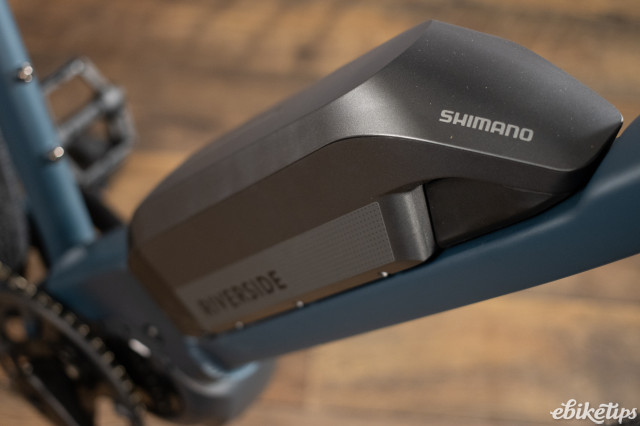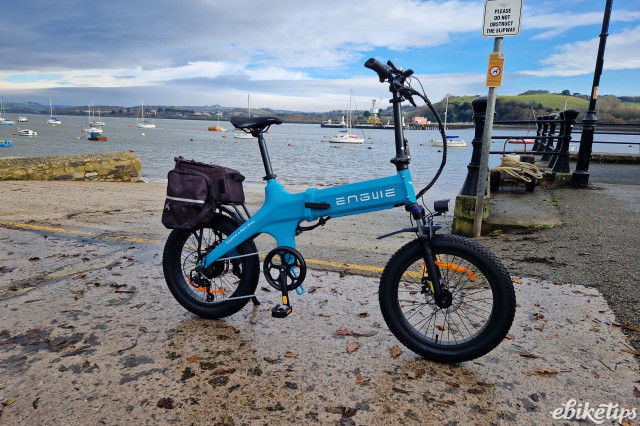We’ve reported on a number of e-bike battery fires in recent times, many off the back off London Fire Brigade’s Charge Safe campaign which was launched in response to rising numbers of e-bike and e-scooter fires in the capital. While the campaign warns of batteries and chargers that do not meet UK safety standards as well as the dangers of sourcing replacements online, this is broad advice and therefore does not necessarily reassure. In this article, Ben Mowbray of E-Bikeshop gives us the lowdown on battery safety and what distinguishes a safe battery from one that is a fire hazard.
With the number of electric bike and scooter fires in the news at the moment, you'd be forgiven for thinking that each one is a ticking time bomb. One day you're joyously riding it to work and the next it's burning down your home. Does this truly represent the overall safety of a product which more and more countries are pushing people towards as a way of reducing car use?
So how often do electric bike and scooter batteries self combust?
Thankfully the answer is "barely ever".
UK insurer Zurich say just 167 fires were reported to local fire departments in the UK during 2022 where the primary cause was a lithium-ion battery for an electric bike or scooter. It's estimated that there are over one million e-scooters (a huge number given they're still illegal in public outside of locally sanctioned pilot schemes) and over half a million electric bikes. This means just 0.011% of bikes and scooters on the market set on fire last year.
Unfortunately, more than one and half a million lithium-ion batteries not setting fire to anything just isn't as newsworthy.
Nevertheless, those that do catch alight are cause for concern, so let's take a look at what might be happening there.
What's inside an e-bike battery?
Safety warning - Never open any lithium-ion battery pack – even "just to look". They're not designed to be user serviceable and exposing internal wiring/busbars can cause short circuits, leading to fires in seconds. Lithium battery fires release hot and highly toxic hydrogen fluoride and phosphoryl fluoride gasses which can cause severe respiratory damage and poisoning.
Your lithium-ion e-bike battery isn't just one big battery in a case, but is actually made up of lots of much smaller ‘cells’ along with several other components which work together to provide power while keeping you safe.
Inside the case are:
Lithium-Ion Cells – Normally 18650 size (18mm wide and 65mm long) but increasingly common now are the larger and more energy dense 20700 and 21700 cells. They might have a manufacturer name and model number along with some serial numbers on them, but are otherwise pretty boring looking because they're only ever meant to be seen by the battery manufacturer.
A ‘sled’ – This is an internal housing for the cells. It maintains their orientation in the pack to ensure mechanical stability – i.e. they should be able to easily absorb the normal knocks and bangs of even the most aggressive mountain bike riding without any internal movement at all, which could sever connections and/or damage the pack irreparably, which could lead to a fire.
The BMS – The battery management system is the second most important component after the battery cells themselves. Controlling charging and discharging rates and continually monitoring the overall pack health and voltage balance, this is a piece of safety apparatus which many very cheap batteries actually leave out entirely. In the event of a fault, it can generate a fault code to display on your e-bike screen (if fitted) and lock the pack from further use to prevent harm to its user.
Inter-cell connections – A specially pressed or laser cut nickel sheet in top end batteries (Bosch, Yamaha, Shimano, etc) or just in ‘off the reel’ strips in lower grade batteries, these silver looking strips form the series and parallel connections in the battery pack and carry current around the pack and out to the motor, or in from the charger via the BMS. There will also be balance leads from the BMS to each cell ‘group’, and perhaps a simple flat lead connection to a charge status indicator on the outside of the battery for user convenience.
Packing materials – These vary in type but can be any mix of specially formulated card, foam, plastic and rubber. These isolate the internal cell sled or carrier from the outer case while providing cushioning from bumps and drops.
The outer case – Most commonly formed from thick, rigid plastic with internal bracing but now very commonly made from light alloys for strength and longevity, this mostly only serves to protect the battery pack inside, but in lots of cases also facilitates the ability to remove and refit the battery for charging, so they're designed to be user friendly.
The differences between major brand and cheap batteries
Having taken a shallow dive into what should be inside your e-bike battery, we can start to look at the differences between batteries manufactured for the top manufacturers of e-bike systems like Bosch, Shimano, Yamaha etc, and what you might expect to find (or not) inside cheaper, often Far Eastern manufactured e-bike batteries.
Yamaha, Bosch, Shimano and other top manufacturers
It might come as a surprise that none of the top manufacturers make all of the components of their own batteries – if any part of it at all.
For example, inside the 630Wh battery fitted in a Haibike FLYON e-bike, you'll find INR18650VTC6 cells made by Murata Manufacturing Co Ltd, who are in turn the principal cell manufacturer for Sony. These cells are used by another German company called BMZ Group to build the battery, before supplying the complete unit back to Haibike for use on their production line when building the bike.
Why? Safety.
Using properly accredited battery pack manufacturers guarantees an exceptional level of engineering design and safety. Bicycle manufacturers are not normally also battery experts. They know what they need (in that they understand and set the performance characteristics required), but that doesn't necessarily mean they're the best people to do it and like most other businesses using lithium-ion battery packs in their products, they sub-contract this work out to proper, internationally accredited manufacturers with world renowned test laboratory facilities. If you need an expert job done, it makes sense to get an expert to do it.
As well as very well built, properly tested and globally accredited batteries, these firms also supply directly compatible and accredited charging solutions. Given that most lithium-ion battery fires start while the product is on charge, this is an often overlooked aspect of overall battery safety.
"Unbranded" manufacturers
At the opposite end of the market are cheaper Far Eastern manufactured batteries and worse still, the DIY market.
Unbranded or ‘white label' batteries, (almost exclusively from the Far East, which is closer to the cell production factories and where materials/labour is cheaper) produce a huge number of batteries which later appear with lots of different brands on them.
These are quite often reasonable quality with a decent BMS and internal connections, but in order to keep prices low, are made with cells from smaller (normally Chinese) cell manufacturers (i.e. not Sony, Samsung, Panasonic, LG, etc). These typically don't perform as well and have much lower cycle lives (the number of times they can be charged before they start to degrade). Often the performance characteristics are trumped up too and as a result they sometimes don't quite provide the level of capacity (range) advertised and only last a couple of years at best.
Some are also very poor quality. Using recycled cells, shoddy internals and no BMS – these are just time bombs waiting to go off.
Below this in the hierarchy of "what makes a good battery" is the DIY market.
DIY batteries
In principle, it's actually very easy to build a very good battery pack yourself so long as you only buy the best quality components and assemble them correctly while following proper electrical engineering principles (it won’t be compatible with the top manufacturer systems though). Right now, it's possible to buy almost everything you need including a spot welder for the cells/nickel strip straight from Amazon and have it delivered in just a few days (what a time to be alive, huh?). A couple of how-to guides on pack building and electrical principles on YouTube can teach you the rest and in several hours you could build something arguably a bit better than some of the imported batteries from a performance point of view. You can also build it to almost any shape you need and so this is quite common in the custom self-build e-bike market. There are a small number of very good private individuals in the UK turning out great custom products, but they're very few in number and don't directly advertise their services.
Unfortunately, these cells were never intended for end user use and putting them into the hands of total novices who might be reckless, ignorant of basic electrical design process or otherwise cut corners has on multiple occasions, due to their volatility, proven to be highly dangerous.
Having spent several years in the lithium-ion tech industry sourcing cells and working on pack design and integration for the prototype EV and personal transport industry, I've seen first-hand some of the monstrosities that people have been turning out in back rooms and sheds across the country and how some of them even made it off the bench they were built on without spontaneously combusting is quite baffling. Old copper wire stripped from broken extension leads soldered directly to the batteries and no BMS is a surefire (no pun intended) route to misery. A tiny mistake when building a battery can have catastrophic consequences in seconds.
As well as normally not having passed all (or indeed any) of the tests the top manufacturers have to put their batteries through to remain compliant, batteries in this category are normally supplied with unbranded/generic chargers and those too can often be poor quality and a primary failure point.
So what causes an e-bike battery to set on fire?
There is no one fixed answer on why an e-bike battery might set on fire, but in almost every case, it's one or more of the following reasons:
Over-discharging – This is normally caused by a faulty (or not fitted at all) BMS. Lithium-ion cells have a DoD or ‘depth of discharge’ limit and in most cases are ‘empty’ at between 2.8 and 3.0 volts (fully charged at 4.2v). Discharging past this low voltage cut off can alter and/or damage the internal chemistry of the cell and the worse this gets and the more frequently it happens, the more the internal resistance of the cells increases over time. This makes it harder for them to expend their energy and when you then ask for more current than they can expend (or faster than they can expend), the cells heat up and this can lead to fire.
Overcharging – This happens in two ways: when a charger doesn't shut itself off when the battery voltage reaches its uppermost level; when the BMS allows the system to be overcharged but doesn’t isolate the battery from the power supply when finished; or both. This can overheat the battery, leading in extreme cases to fire. It can also be from trying to charge too quickly. This is normally a result of not using the correct charger – i.e. a charger with a supply current and/or voltage higher than the battery is able to safely manage. This too leads to overheating, and subsequently fire if the BMS or charger doesn't recognise the issue and isolate itself.
Bad quality or no BMS – As well as reducing the likelihood of the above two scenarios, the BMS itself is also a potential failure point. Bad quality ones tend to fail in the ‘on’ position. In other words, when it fails it effectively ceases to exists and allows the battery to be overcharged and over-discharged, sometimes without any real warning. Good quality BMS like those found in Bosch and Yamaha systems fail ‘off’ and are connected to the central control system of the bike. They will not only lock up the battery from being used, but will remain ‘contactable’ and when plugged into diagnostics, an authorised repair centre will be able to see exactly what has gone wrong.
Mechanical/physical damage – Good quality batteries have the ability to deal with the normal bumps, jolts and scrapes that even aggressive mountain biking brings, but none are infallible. If your battery suffers a drop or fall of more than a few feet onto a hard surface or has any new rattles, it should be inspected by an authorised repair centre. Drops from more than a foot or two onto hard surfaces could dislodge components leading to internal short circuits which can in turn lead to fires.
Thermal runaway – Thermal runaway is almost always a secondary effect to one or more of the above external factors and doesn't simply just ‘happen’. Over-charging, over-discharging, leaving the battery exposed to extreme (60C+) temperatures or severe impacts can lead to internal shorts which gradually heat the battery pack beyond safe working limits, causing the cells inside to ‘vent’. This is characterised by a popping noise, followed immediately by a hiss as a cell vents its rising internal pressure. Cells like the cheap Chinese unbranded ones which don't have this manufactured-in weak point (a ‘burst disc’) tend to just violently explode instead.
Minimising your risk of e-bike battery fires
The bike and battery – It should go without saying, but only purchase your e-bike from reputable retailers/dealers selling well recognised and widely reviewed brands. If you can only find it on eBay/Amazon, can’t find anything about it outside of its own website, or it’s an ‘online only’ business (excluding well known direct-to-consumer brands), then you might consider these red flags.
Not only will the quality be unknown, but the availability of parts and spares will be next to non-existent and support will likely be outside the UK too – if indeed there is any.
Regardless of manufacturer, if you damage your battery or it develops a fault (normally indicated by an error light of some sort or on its screen), never attempt to open or self-diagnose it. Contact your place of purchase immediately and they should be very happy to provide help and advice on a route to repair or replacement.
Charging – Only use the charger supplied with your bike or another which has been approved by the manufacturer (Bosch for example have Compact, Standard and Fast smart chargers compatible with all of their bikes, regardless of the battery fitted). If you lose or damage your charger, contact your place of purchase for a direct or manufacturer approved replacement. Don't be tempted by a cheaper aftermarket option which claims to be compatible. These are known to often be of poor quality and will invalidate your warranty.
Never leave a charging bike unattended. Lithium-ion batteries can go from a small fizzle and puff of smoke to a red hot, poisonous gas spewing inferno in less than a minute and can be very difficult to put out without specialist equipment. Always make sure you've switched off and disconnected the charger from the mains when it’s finished charging.











